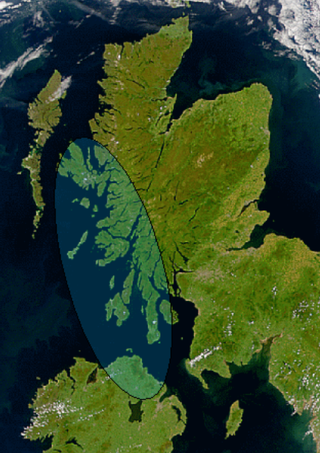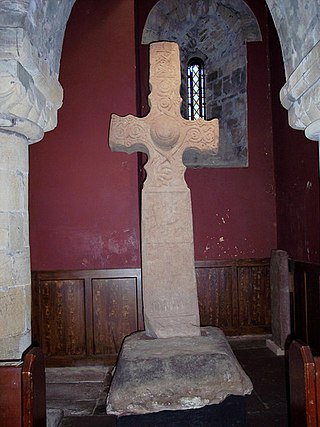Related Research Articles

Dál Riata or Dál Riada was a Gaelic kingdom that encompassed the western seaboard of Scotland and north-eastern Ireland, on each side of the North Channel. At its height in the 6th and 7th centuries, it covered what is now Argyll in Scotland and part of County Antrim in Northern Ireland. After a period of expansion, Dál Riata eventually became associated with the Gaelic Kingdom of Alba.
Óengus mac Fergusa was king of the Picts from 820 until 834. In Scottish historiography, he is associated with the veneration of Saint Andrew, the patron saint of Scotland, although this has not been proven.

Causantín or Constantín mac Fergusa (789–820) was king of the Picts, in modern Scotland, from 789 until 820. He was until the Victorian era sometimes counted as Constantine I of Scotland; the title is now generally given to Causantín mac Cináeda. He is credited with having founded the church at Dunkeld which later received relics of St Columba from Iona.

Áedán mac Gabráin, also written as Aedan, was a king of Dál Riata from c. 574 until c. 609 AD. The kingdom of Dál Riata was situated in modern Argyll and Bute, Scotland, and parts of County Antrim, Ireland. Genealogies record that Áedán was a son of Gabrán mac Domangairt.
Naiton son of Der-Ilei, also called Naiton son of Dargart, was king of the Picts between 706–724 and between 728–729. He succeeded his brother Bridei IV in 706. He is associated with significant religious reforms in Pictland. He abdicated in 724 in favour of his nephew and became a monk. In 728 and 729 he fought in a four-sided war for the Pictish throne.
Ciniod, Cináed or Cinadhon, son of Uuredech, was king of the Picts from 763 until 775.

Bridei son of Beli, died 692 was king of Fortriu and of the Picts from 671 until 692. His reign marks the start of the period known to historians as the Verturian hegemony, a turning point in the history of Scotland, when the uniting of Pictish provinces under the over-kingship of the kings of Fortriu saw the development of a strong Pictish state and identity encompassing most of the peoples north of the Forth.
Drest was king of the Picts from 724 until 726. He succeeded Nechtan mac Der-Ilei when the latter abdicated and entered a monastery in 724.
Bridei son of Der-Ilei was king of the Picts from 697 until 706. He became king when Taran was deposed in 697.
Nechtan, son of Erip, was the king of the Picts from 456 to 480.
Gartnait, son of Domelch, was a king of the Picts from 584 to 595.
Neithon son of Guipno was a 7th-century ruler of Alt Clut, a Brittonic kingdom based on Dumbarton Rock. According to the Harleian genealogies, he was the son of Guipno map Dumnagual Hen. Alfred Smyth suggests he is the same man as King Nechtan the Great of the Picts, and perhaps the Nechtan son of Canu the Annals of Ulster record as having died in 621. The Senchus fer n-Alban indicate that Gartnait, the son of Áedán mac Gabráin, King of Dál Riata, sired a son named Cano, but unless the Harleian genealogies are to be ignored, this would make Gartnait and Dumnagual Hen the same persons, as the respective fathers of Gartnait and Guipno. However, it is possible that either as an Alt Clut Briton ascending the throne of Pictland, or as a Pict ascending the throne of Alt Clut, his genealogy might have been altered, and it is notable that in the Pictish king-lists he is called "Nechtan, nepos Uerb", suggesting that it was a descent from Uerb that mattered in Pictland, and not his unimportant father Guipno/Canu. Alan Orr Anderson pointed out that Uerb is probably the Pictish form of Ferb, a female name. Alan MacQuarrie suggests that Neithon was indeed the Pictish king Nechtan, but does not take any stance on the Guipno/Canu problem.
Elfin was a ruler of Alt Clut, a Brittonic kingdom based on Dumbarton Rock, sometime in the later 7th century. According to the Harleian genealogies, he was the son of Eugein I, one of his predecessors as king, and the father of Beli II, who ruled some time later. Very little is certainly known of him, though he may be identifiable with other figures attested in the Irish annals, and circumstantial evidence may link him to a number of important events during this time.
Gartnait son of Donuel was king of the Picts from 657 until 663.
Galam Cennalath was a king of the Picts from 550 to 555.
Drest son of Donuel was king of the Picts from c. 663 until 672. Like his brother and predecessor Gartnait son of Donuel, and Gartnait's predecessor Talorgan son of Eanfrith, he reigned as a puppet king under the Northumbrian king Oswiu. Gartnait and Drest may have been sons of Domnall Brecc, who was king of Dál Riata from c. 629 until he was killed in 642.
Talorg son of Uuid was a king of the Picts from 641 to 653.
Alpín was king of the Picts from 726–728, together with Drest VII. The Pictish Chronicle king lists give Alpín and Drest a five-year joint rule.
Gwid son of Peithan was a warband leader allied with the northern Britons fighting against the Angles of Northumbria in the early 7th century, recorded in the Welsh poem Y Gododdin. He is described in Y Gododdin as a "steadfast warrior" and may have been either a southern Pict or a northern British chief.
References
- ↑ The word nepos can mean grandson or nephew, but probably means nephew; some variants read "son of". Perhaps a female name, cognate with the Old Irish Ferb; ESSH p. 145, note 3. Variant forms include Uerp, Irb and Yrp. These are similar to the patronyms Uuirp, Erp, Erip, Irb, Yrb and Eirip which are used of Drest I and Nechtan I.
- ↑ Smyth, pp. 62–65 and table 2.
- ↑ Nechtan son of Guipno per Smyth, pp. 62–65 and table 2.
- ↑ Bannerman, pp. 92–94. This is a chronologically improbable theory as it would make a great-grandson of Áedán a king in the 6th century
- ↑ Early Sources, pp. cxx–cxxi, quoting Skene's Chronicles of the Picts & Scots. For the dating, see Smyth, p. 82; ESSH, p. 145, note 3.
- ↑ See also ESSH, p. 145, note 3, where it is noted that the Aberdeen Breviary says Pope Boniface IV (617–624) sent a mission to Pictland.